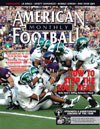AMERICAN FOOTBALL MONTHLY THE #1 RESOURCE FOR FOOTBALL COACHES
Article CategoriesAFM Magazine
|
Complementary Runs Off of the Zone Readby: Tom HermanOffensive Coordinator and Quarterbacks Coach, Rice University © More from this issue We base our offense out of the Shotgun, while playing with one running back, one tight end and three WRs a majority of the time. Our ‘bread and butter’ run play that we hang our hat on is the inside zone read. We base our entire run game around finding ways to run that specific play while having complementary runs that allow us to be successful when defenses make it difficult to run the zone read. The first complementary run we employ is the one-back power (See Diagrams 1-3). We feel that this run allows us to create double teams and angles at the point of attack, while providing us a ‘downhill’ run from the Shotgun. We will always run the one back power to a tight end and we will only run it to some form of six defenders in the box. We call this run when we are getting stagnant linebackers (i.e., trying to play both the....The full article can only be seen by subscribers. Subscribe today!
|
|
|||||||
| HOME |
MAGAZINE |
SUBSCRIBE | ONLINE COLUMNISTS | COACHING VIDEOS |
Copyright 2025, AmericanFootballMonthly.com
All Rights Reserved





